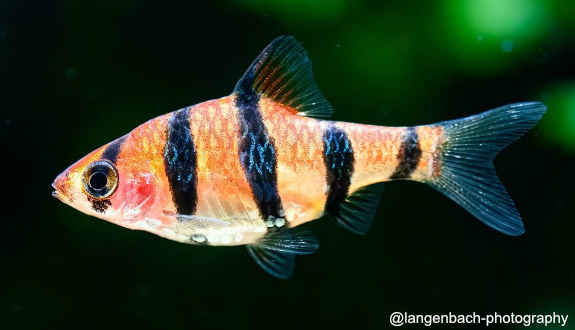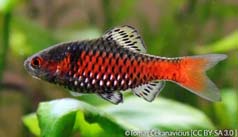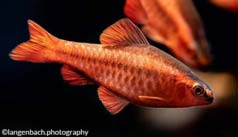

Alternative species (click on the thumbnail to see the card)
Names
Scientific name
Desmopuntius pentazona
Barbus pentazona
Barbus pentazona pentazona
Puntius pentazona
Capoeta pentazona
Systomus pentazona
Common name
Fiveband barb
Five-band barb
Origin

Origin: Borneo, Sumatra, Malaysian Peninsula
Biotope: Asian
Dimorphism

The male is more colourful, thinner and slightly smaller than the female.
Group

Cyprinidae
Volume

120 L / 26 Imp Gal / 32 US Gal
Parameters

T°: 24 to 26°C or 75 to 79°F
pH: 6 to 6.5
Hardness: 1 to 10°dGH
Difficulty

Easy
Size

4 to 8cm (1.6 to 3.2")
Longevity

3 to 5 years
Living zone

Middle and depth
Individuals

10
Food
How to feed the Fiveband barb?
Food
How to feed the Fiveband barb?
The Fiveband barb is a carnivore and a hunter. Therefore, it has little appetite for the usual freeze-dried foods. On the other hand, offer him live food (this is ideal) or frozen food and he will eat it greedily! You can particularly choose the insect larvae he is fond of: tubifex, mud worms, Grindal worms.... Other small crustaceans such as artemia, daphnia, mysis... will also do the trick.
Make sure the prey is the right size for their small mouths.
Behavior
What kind of behavior does the Fiveband barb have?
Behavior
What kind of behavior does the Fiveband barb have?
Unlike its cousin Tiger barb, this fish is rather shy and calm. They will absolutely need the presence of their fellow fish to calm them down. If it finds itself isolated, or if the group is not big enough, it will spend its time stressing and can become aggressive. What a pity when we know how beautiful and fascinating they are when he is helping out in his environment!
Cohabitation
Who can live with the Fiveband barb?
Cohabitation
Who can live with the Fiveband barb?
Like all Barb, the Fiveband barb must be kept in a group. For this species, start with a group of at least 10 individuals. Note that a group only forms between members of the same species (for example, 5 Fiveband barb and 5 Tiger barb will not form a group of 10, but 2 groups of 5).
Because of its reserved nature, it will be necessary to add peaceful, calm and not too large species to them. Indeed, too much activity from their roommates will intimidate them. Also avoid species with large fins such as the Guppy or Betta, as this type of cohabitation does not generally work well (problem of fin nibbling).
You can harmoniously add dwarf Gouramis or honey Gouramis to them. The association with other barb animals is also possible in adequate volumes.
Breeding
How to breed the Fiveband barb?
Breeding
How to breed the Fiveband barb?
Spawning shouldn't be a problem. On the other hand, rearing the fry is more difficult because they are very fragile.
Your fish reach their sexual maturity at the age of 10/12 months. To reproduce them efficiently, prepare a small aquarium of about 30 litres (6 Imp Gal / 8 US Gal) with many fine-leafed plants such as Java moss. The recommended water parameters are: temperature at 26°C (79°F), pH at 6 and hardness less than or equal to 5°dGH. Filtering on peat would be a plus.
Introduce in this aquarium a couple of your choice and stimulate spawning by feeding them live prey. Also increase the temperature to 27/28°C (81/82°F). Please note, however, that not all couples are willing to spawn. If your pair does not spawn after a few days, try another pair.
The eggs are laid directly on the ground or on the plants. Once spawning has taken place, remove the spawners from the breeding aquarium. The brood contains between 150 and 400 eggs. The eggs are yellow-orange and beautifully sized. Incubation lasts 26 to 30 hours.
The fry start free-swimming after 4 to 5 days.
Growth is fairly fast at first, but will slow down after 2 or 3 months. Unfortunately, the rearing of the fry is delicate, and the mortality rate is quite high. Indeed, they are very fragile and sensitive to water pollution. To promote their growth, make small water changes but very often.
The set of parameters must be rigorously identical because they are also sensitive to parameter variations. Finally, note that new water is not suitable for them. Before you change your water, prepare it and let it age for a while.
Feeding the fry: infusing then nauplias of artemia or cyclops. Distribute food only after the fifth or sixth day because before that, the fry will consume its yolk sac.
Its aquarium
Which aquarium for the Fiveband barb?
Its aquarium
Which aquarium for the Fiveband barb?
Its natural habitat is rather calm water. To reproduce its natural environment, go to an aquarium in an Asian biotope.
As this fish is rather shy, it will appreciate the presence of large-leaved plants and floating plants that shade the aquarium (it does not like too intense lighting). However, make sure that you leave enough space so that swimming is not hindered (even if it is calm, it is a good swimmer). Peat bog roots and dark soil will also help to calm him down. This environment is ideal for securing the fish, and enhances its beautiful coloration!
To keep the water healthy and clean, change ¼ the volume of the aquarium every week. Peat filtration will be a plus.
Good To know
Find all additional information!
Good To know
Find all additional information!
Close enough to the Puntigrus tetrazona, the latter has 4 black stripes, compared to 5 for the Desmopuntius pentazona.
Like all fish that stress easily, it can be particularly prone to white spot disease.
Yours photos!
Comments
Sort by:
Please login to post comments



